Martijn Bartelds
BLAB: Brutally Long Audio Bench
May 05, 2025Abstract:Developing large audio language models (LMs) capable of understanding diverse spoken interactions is essential for accommodating the multimodal nature of human communication and can increase the accessibility of language technologies across different user populations. Recent work on audio LMs has primarily evaluated their performance on short audio segments, typically under 30 seconds, with limited exploration of long-form conversational speech segments that more closely reflect natural user interactions with these models. We introduce Brutally Long Audio Bench (BLAB), a challenging long-form audio benchmark that evaluates audio LMs on localization, duration estimation, emotion, and counting tasks using audio segments averaging 51 minutes in length. BLAB consists of 833+ hours of diverse, full-length audio clips, each paired with human-annotated, text-based natural language questions and answers. Our audio data were collected from permissively licensed sources and underwent a human-assisted filtering process to ensure task compliance. We evaluate six open-source and proprietary audio LMs on BLAB and find that all of them, including advanced models such as Gemini 2.0 Pro and GPT-4o, struggle with the tasks in BLAB. Our comprehensive analysis reveals key insights into the trade-offs between task difficulty and audio duration. In general, we find that audio LMs struggle with long-form speech, with performance declining as duration increases. They perform poorly on localization, temporal reasoning, counting, and struggle to understand non-phonemic information, relying more on prompts than audio content. BLAB serves as a challenging evaluation framework to develop audio LMs with robust long-form audio understanding capabilities.
CTC-DRO: Robust Optimization for Reducing Language Disparities in Speech Recognition
Feb 03, 2025Abstract:Modern deep learning models often achieve high overall performance, but consistently fail on specific subgroups. Group distributionally robust optimization (group DRO) addresses this problem by minimizing the worst-group loss, but it fails when group losses misrepresent performance differences between groups. This is common in domains like speech, where the widely used connectionist temporal classification (CTC) loss scales with input length and varies with linguistic and acoustic properties, leading to spurious differences between group losses. We present CTC-DRO, which addresses the shortcomings of the group DRO objective by smoothing the group weight update to prevent overemphasis on consistently high-loss groups, while using input length-matched batching to mitigate CTC's scaling issues. We evaluate CTC-DRO on the task of multilingual automatic speech recognition (ASR) across five language sets from the ML-SUPERB 2.0 benchmark. CTC-DRO consistently outperforms group DRO and CTC-based baseline models, reducing the worst-language error by up to 65.9% and the average error by up to 47.7%. CTC-DRO can be applied to ASR with minimal computational costs, and offers the potential for reducing group disparities in other domains with similar challenges.
ML-SUPERB 2.0: Benchmarking Multilingual Speech Models Across Modeling Constraints, Languages, and Datasets
Jun 12, 2024



Abstract:ML-SUPERB evaluates self-supervised learning (SSL) models on the tasks of language identification and automatic speech recognition (ASR). This benchmark treats the models as feature extractors and uses a single shallow downstream model, which can be fine-tuned for a downstream task. However, real-world use cases may require different configurations. This paper presents ML-SUPERB~2.0, which is a new benchmark for evaluating pre-trained SSL and supervised speech models across downstream models, fine-tuning setups, and efficient model adaptation approaches. We find performance improvements over the setup of ML-SUPERB. However, performance depends on the downstream model design. Also, we find large performance differences between languages and datasets, suggesting the need for more targeted approaches to improve multilingual ASR performance.
Making More of Little Data: Improving Low-Resource Automatic Speech Recognition Using Data Augmentation
May 19, 2023Abstract:The performance of automatic speech recognition (ASR) systems has advanced substantially in recent years, particularly for languages for which a large amount of transcribed speech is available. Unfortunately, for low-resource languages, such as minority languages, regional languages or dialects, ASR performance generally remains much lower. In this study, we investigate whether data augmentation techniques could help improve low-resource ASR performance, focusing on four typologically diverse minority languages or language variants (West Germanic: Gronings, West-Frisian; Malayo-Polynesian: Besemah, Nasal). For all four languages, we examine the use of self-training, where an ASR system trained with the available human-transcribed data is used to generate transcriptions, which are then combined with the original data to train a new ASR system. For Gronings, for which there was a pre-existing text-to-speech (TTS) system available, we also examined the use of TTS to generate ASR training data from text-only sources. We find that using a self-training approach consistently yields improved performance (a relative WER reduction up to 20.5% compared to using an ASR system trained on 24 minutes of manually transcribed speech). The performance gain from TTS augmentation for Gronings was even stronger (up to 25.5% relative reduction in WER compared to a system based on 24 minutes of manually transcribed speech). In sum, our results show the benefit of using self-training or (if possible) TTS-generated data as an efficient solution to overcome the limitations of data availability for resource-scarce languages in order to improve ASR performance.
Leveraging supplementary text data to kick-start automatic speech recognition system development with limited transcriptions
Feb 09, 2023Abstract:Recent research using pre-trained transformer models suggests that just 10 minutes of transcribed speech may be enough to fine-tune such a model for automatic speech recognition (ASR) -- at least if we can also leverage vast amounts of text data (803 million tokens). But is that much text data necessary? We study the use of different amounts of text data, both for creating a lexicon that constrains ASR decoding to possible words (e.g. *dogz vs. dogs), and for training larger language models that bias the system toward probable word sequences (e.g. too dogs vs. two dogs). We perform experiments using 10 minutes of transcribed speech from English (for replicating prior work) and two additional pairs of languages differing in the availability of supplemental text data: Gronings and Frisian (~7.5M token corpora available), and Besemah and Nasal (only small lexica available). For all languages, we found that using only a lexicon did not appreciably improve ASR performance. For Gronings and Frisian, we found that lexica and language models derived from 'novel-length' 80k token subcorpora reduced the word error rate (WER) to 39% on average. Our findings suggest that where a text corpus in the upper tens of thousands of tokens or more is available, fine-tuning a transformer model with just tens of minutes of transcribed speech holds some promise towards obtaining human-correctable transcriptions near the 30% WER rule-of-thumb.
Quantifying Language Variation Acoustically with Few Resources
May 05, 2022



Abstract:Deep acoustic models represent linguistic information based on massive amounts of data. Unfortunately, for regional languages and dialects such resources are mostly not available. However, deep acoustic models might have learned linguistic information that transfers to low-resource languages. In this study, we evaluate whether this is the case through the task of distinguishing low-resource (Dutch) regional varieties. By extracting embeddings from the hidden layers of various wav2vec 2.0 models (including new models which are pre-trained and/or fine-tuned on Dutch) and using dynamic time warping, we compute pairwise pronunciation differences averaged over 10 words for over 100 individual dialects from four (regional) languages. We then cluster the resulting difference matrix in four groups and compare these to a gold standard, and a partitioning on the basis of comparing phonetic transcriptions. Our results show that acoustic models outperform the (traditional) transcription-based approach without requiring phonetic transcriptions, with the best performance achieved by the multilingual XLSR-53 model fine-tuned on Dutch. On the basis of only six seconds of speech, the resulting clustering closely matches the gold standard.
Automated speech tools for helping communities process restricted-access corpora for language revival efforts
Apr 24, 2022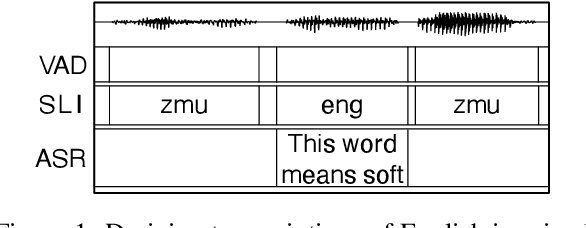
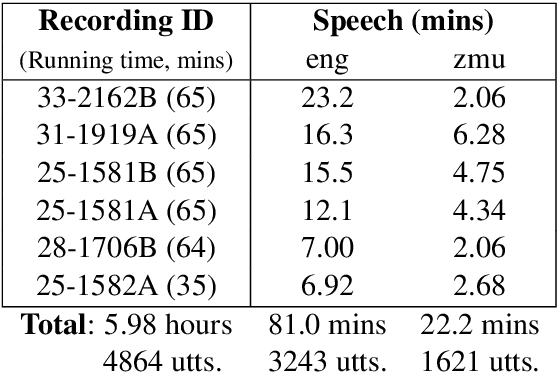
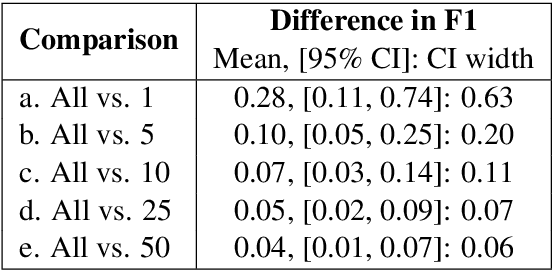
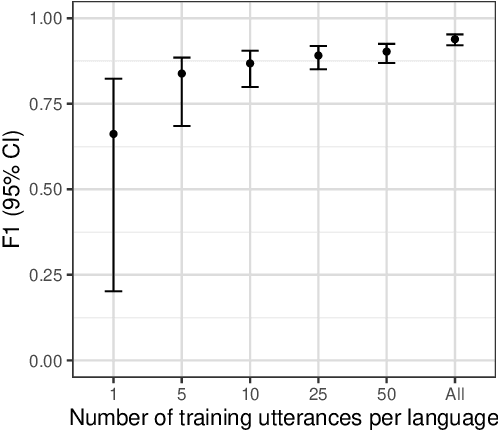
Abstract:Many archival recordings of speech from endangered languages remain unannotated and inaccessible to community members and language learning programs. One bottleneck is the time-intensive nature of annotation. An even narrower bottleneck occurs for recordings with access constraints, such as language that must be vetted or filtered by authorised community members before annotation can begin. We propose a privacy-preserving workflow to widen both bottlenecks for recordings where speech in the endangered language is intermixed with a more widely-used language such as English for meta-linguistic commentary and questions (e.g. What is the word for 'tree'?). We integrate voice activity detection (VAD), spoken language identification (SLI), and automatic speech recognition (ASR) to transcribe the metalinguistic content, which an authorised person can quickly scan to triage recordings that can be annotated by people with lower levels of access. We report work-in-progress processing 136 hours archival audio containing a mix of English and Muruwari. Our collaborative work with the Muruwari custodian of the archival materials show that this workflow reduces metalanguage transcription time by 20% even given only minimal amounts of annotated training data: 10 utterances per language for SLI and for ASR at most 39 minutes, and possibly as little as 39 seconds.
Adapting Monolingual Models: Data can be Scarce when Language Similarity is High
May 22, 2021



Abstract:For many (minority) languages, the resources needed to train large models are not available. We investigate the performance of zero-shot transfer learning with as little data as possible, and the influence of language similarity in this process. We retrain the lexical layers of four BERT-based models using data from two low-resource target language varieties, while the Transformer layers are independently fine-tuned on a POS-tagging task in the model's source language. By combining the new lexical layers and fine-tuned Transformer layers, we achieve high task performance for both target languages. With high language similarity, 10MB of data appears sufficient to achieve substantial monolingual transfer performance. Monolingual BERT-based models generally achieve higher downstream task performance after retraining the lexical layer than multilingual BERT, even when the target language is included in the multilingual model.
Leveraging neural representations for facilitating access to untranscribed speech from endangered languages
Mar 26, 2021

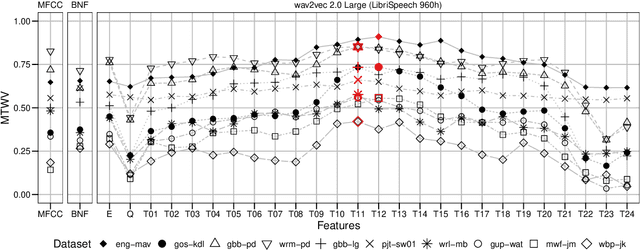
Abstract:For languages with insufficient resources to train speech recognition systems, query-by-example spoken term detection (QbE-STD) offers a way of accessing an untranscribed speech corpus by helping identify regions where spoken query terms occur. Yet retrieval performance can be poor when the query and corpus are spoken by different speakers and produced in different recording conditions. Using data selected from a variety of speakers and recording conditions from 7 Australian Aboriginal languages and a regional variety of Dutch, all of which are endangered or vulnerable, we evaluated whether QbE-STD performance on these languages could be improved by leveraging representations extracted from the pre-trained English wav2vec 2.0 model. Compared to the use of Mel-frequency cepstral coefficients and bottleneck features, we find that representations from the middle layers of the wav2vec 2.0 Transformer offer large gains in task performance (between 56% and 86%). While features extracted using the pre-trained English model yielded improved detection on all the evaluation languages, better detection performance was associated with the evaluation language's phonological similarity to English.
Neural Representations for Modeling Variation in English Speech
Nov 25, 2020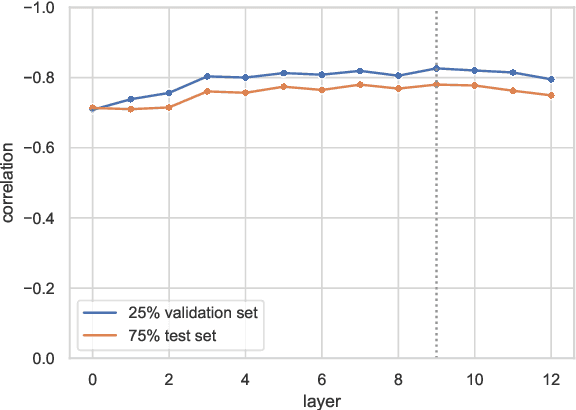
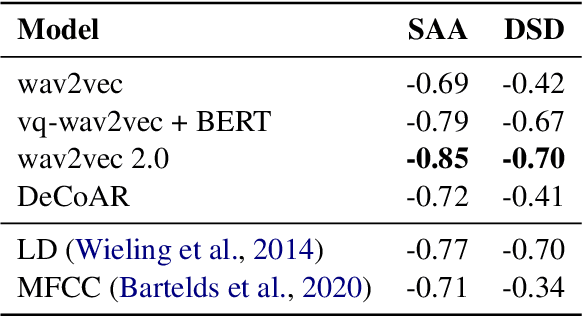
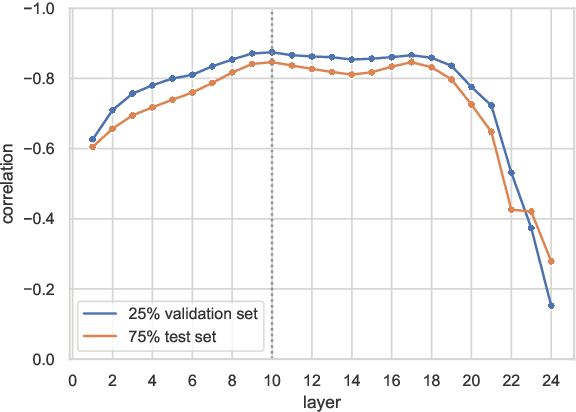
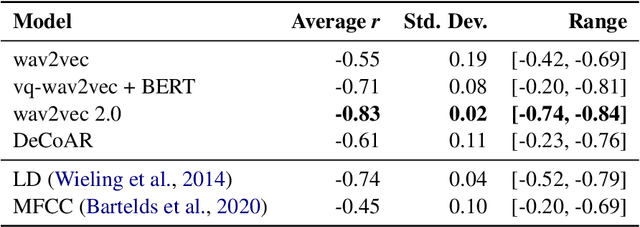
Abstract:Variation in speech is often represented and investigated using phonetic transcriptions, but transcribing speech is time-consuming and error prone. To create reliable representations of speech independent from phonetic transcriptions, we investigate the extraction of acoustic embeddings from several self-supervised neural models. We use these representations to compute word-based pronunciation differences between non-native and native speakers of English, and evaluate these differences by comparing them with human native-likeness judgments. We show that Transformer-based speech representations lead to significant performance gains over the use of phonetic transcriptions, and find that feature-based use of Transformer models is most effective with one or more middle layers instead of the final layer. We also demonstrate that these neural speech representations not only capture segmental differences, but also intonational and durational differences that cannot be represented by a set of discrete symbols used in phonetic transcriptions.
 Add to Chrome
Add to Chrome Add to Firefox
Add to Firefox Add to Edge
Add to Edge